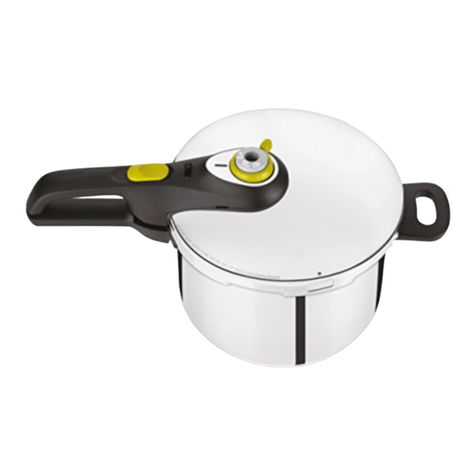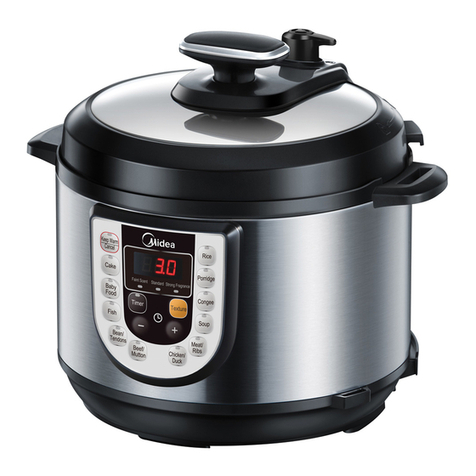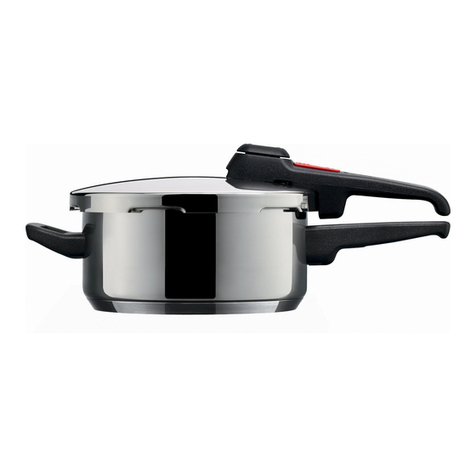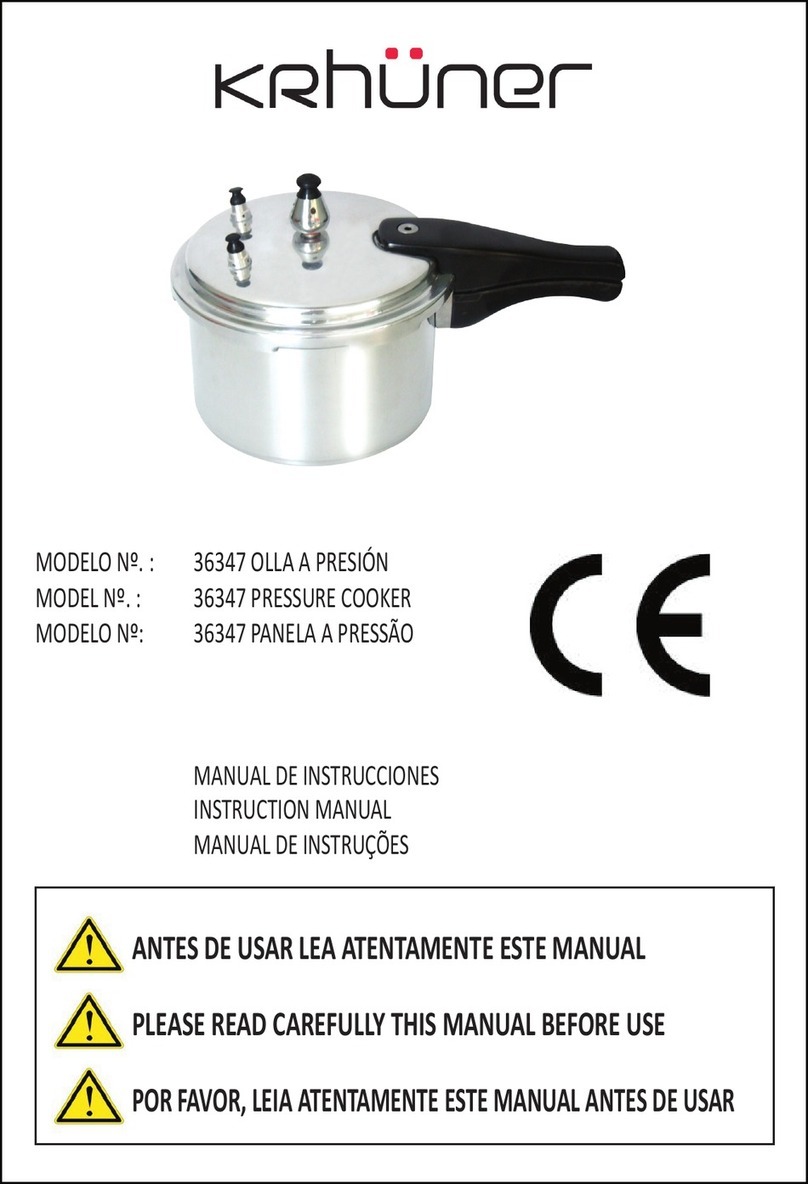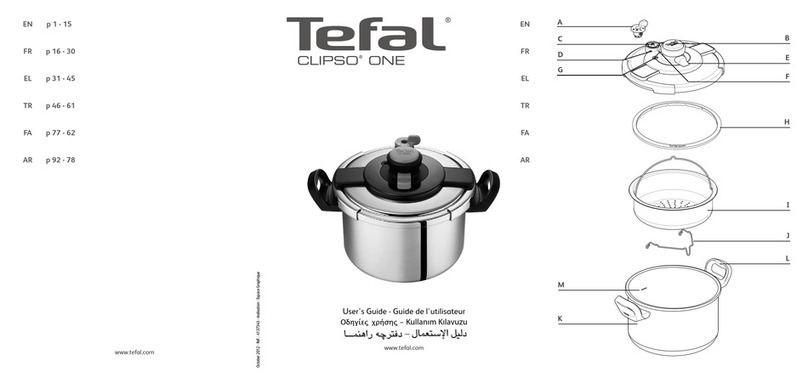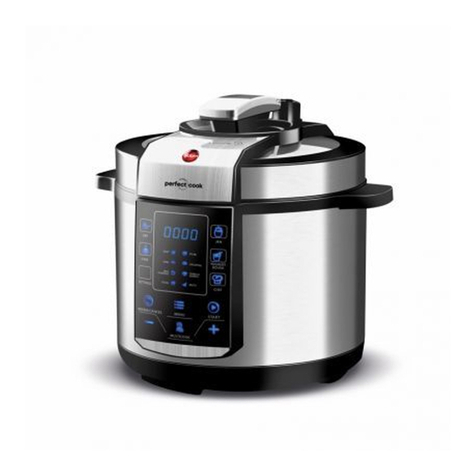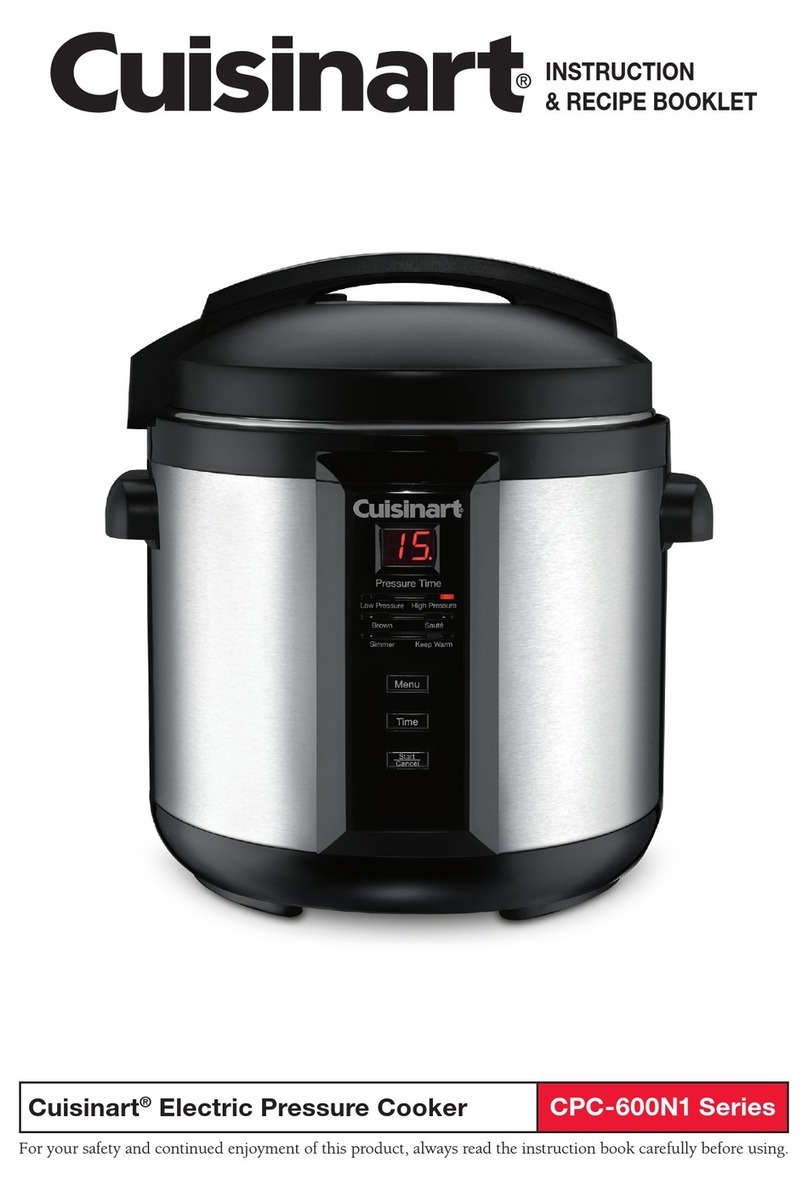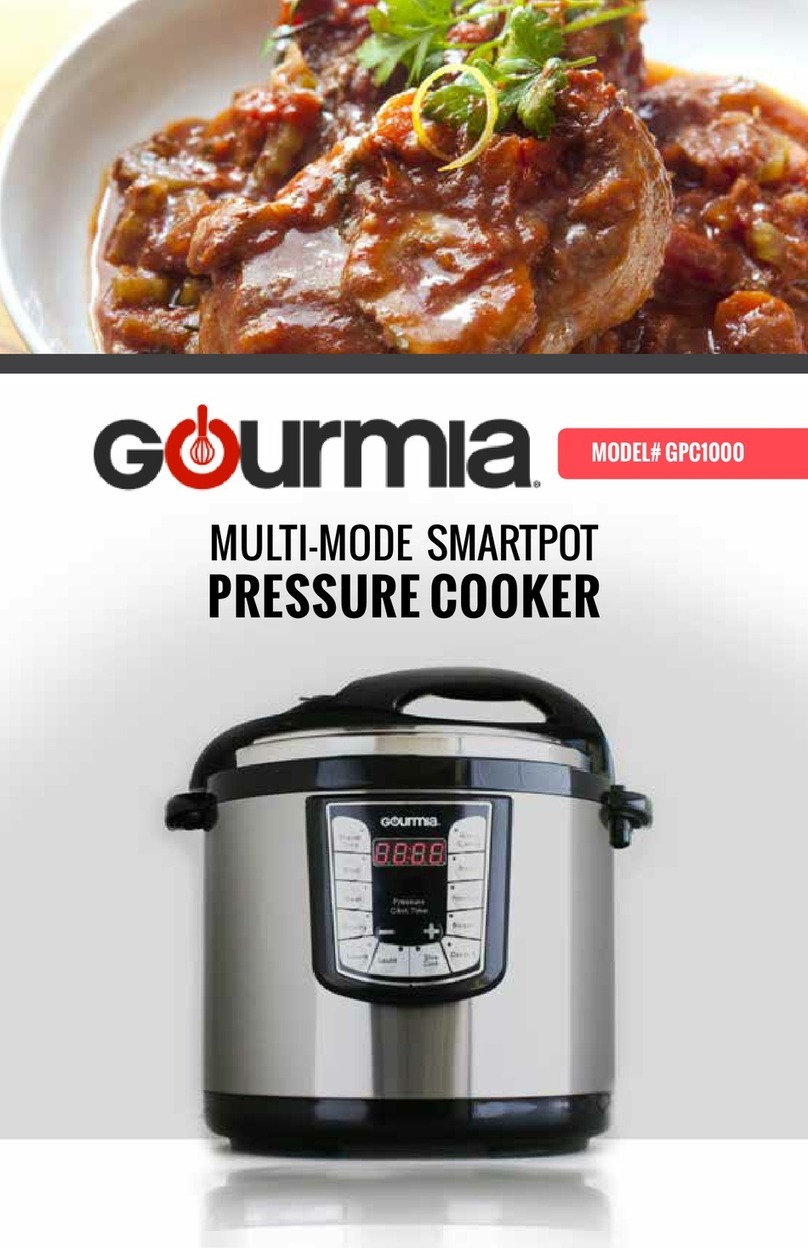T-Fal P25042 User manual

www.t-falusa.com
Réf INSF2 • 11/2010 • Subject to modifications
ESPACE GRAPHIQUE
EN
ES
EN p. 1
ES p. 15 A
B
H
J
N
O
C
D
E
F
G
I
K
L
M
Pressure Cooker
User’s Guide
Guía del usuario
Descriptive diagram
Healthy Express
TF_PRESSURE_COOKER_HEALTY_EXPRESS_INSF2_USA 16/11/10 15:40 PageC1

30
1
Fig 1 Fig 2 Fig 3
CLICK
Fig 4 Fig 5
1
3
2
31
2
Fig 6
Fig 7 Fig 8 Fig 9
Fig 10 Fig 11 Fig 12
Fig 13 Fig 14
Table of contents
Important safeguards p 2
Descriptive diagram p 3
Characteristics p 3
Compatible heat sources p 3
T-fal accessories p 4
Operating instructions p 4
Opening p 4
Closing p 4
Minimum filling p 5
Maximum filling p 5
Food preparation instructions p 5
Using the operating valve p 5
Using for the first time p 6
Before cooking p 6
During cooking p 7
Finishing cooking p 7
Care and cleaning p 7
Cleaning the pressure cooker p 7
Safety features p 9
Recommendations for use p 10
Regulation markings p 10
T-fal and your frequently asked questions p 11
Table of cooking times p 12
Limited Warranty p 13
TF_PRESSURE_COOKER_HEALTY_EXPRESS_INSF2_USA 16/11/10 15:45 PageC4

2
EN
ES
ES
PT
EL
AR
FA
IMPORTANT SAFEGUARDS
When using pressure cookers, basic safety precautions should
always be followed :
1. Read all instructions.
2. Do not touch hot surfaces. Use handles or knobs.
3. Close supervision is necessary when the pressure cooker is used
near children.
4. Do not place the pressure cooker in a heated oven.
5. Extreme caution must be used when moving a pressure
cooker containing hot liquids.
6. Do not use pressure cooker for other than intended use.
7. This appliance cooks under pressure. Improper use may result in
scalding injury. Make certain unit is properly closed before opera-
ting. See “Operating Instructions.”
8. Do not fill the unit over 2/3 full. When cooking foods that expand
during cooking such as rice or dried vegetables, do not fill the unit
over ½ full. Over filling may cause a risk of clogging the vent pipe
and developing excess pressure. See “Food Preparation Instructions.”
9. Be aware that certain foods, such as applesauce, cranberries, pearl
barley, oatmeal or other cereals, split peas, noodles, macaroni, rhu-
barb, or spaghetti can foam, froth, and sputter, and clog the pres-
sure release device (steam vent). These foods should not be cooked
in a pressure cooker.
10. Always check the pressure release devices for clogging
before use.
11. Do not open the pressure cooker until the unit has cooled and all
internal pressure has been released. If the handles are difficult to
push apart, this indicates that the cooker is still pressurized – do
not force it open. Any pressure in the cooker can be hazardous.
See “Operating Instructions”.
12. Do not use this pressure cooker for pressure frying with oil.
13. When the normal operating pressure is reached, turn the heat down
so all the liquid, which creates the steam, does not evaporate.
14. Always pour a minimum amount of a liquid of at least
8.5 oz in the unit. See "Operating Instructions".
SAVE THESE INSTRUCTIONS.
TF_PRESSURE_COOKER_HEALTY_EXPRESS_INSF2_USA 16/11/10 15:41 Page2

3
Descriptive diagram
Characteristics
Pressure cooker base diameter - model references
Standards information:
Upper operating pressure limit: 80 kPa (12 psi).
Maximum safety pressure limit: 170 kPa (25 psi).
Compatible heat sources
• The Healthy Express pressure cooker can
be used on all heat sources.
• When using an electric hob or induction, make sure
that the size of the hot plate does not exceed the
size of the pressure cooker base.
• On a ceramic or halogen hob, always make sure that
the pressure cooker base is clean and dry.
A- Operating valve
B- Operating valve seat
C- Safety valve
D- Pressure indicator
E- Opening button
F- Long lid handle
G- Lid positioning mark
H- Operating valve positioning mark
I- Lid gasket
J- Steam basket
K- Steam basket support
L- Long pressure cooker body
handle
M- Pressure cooker body
N- Short pressure cooker body
handle
O- Maximum filling mark
Capacity Cooker
diameter
Base
diameter model Item number Lid and body
material
4.2 qt 4L 8.6" 7.5" P25042 YS2H3964 /
YS223H39
Stainless
steel
6.3 qt 6L 8.6" 7.5" P25007 YS2H3664 /
YS223H36
7.4 qt 7L 8.6" 7.5" P25008 YS2H4064 /
YS223H40
GAS SOLID
HOTPLATE
CERAMIC
or
HALOGEN
INDUCTION ELECTRIC
HOTPLATE
TF_PRESSURE_COOKER_HEALTY_EXPRESS_INSF2_USA 16/11/10 15:41 Page3

4
EN
ES
ES
PT
EL
AR
FA
• On a gas hob, the flame should not extend past the
diameter of the pressure cooker base.
T-fal accessories
•The following Healthy Express pressure
cooker accessories are available :
• To replace other parts or have repairs performed, please
call on your local T-fal Approved Service Center.
• Only use T-fal genuine parts designed for your pro-
duct model.
Operating Instructions
This appliance cooks under pressure. Improper use may result in scalding in-
jury. Make certain unit is properly closed before operating.
Always pour a minimum amount of a liquid of at least 8.5 oz in the unit.
Opening
• Using your thumb, pull on the opening knob (E)
and move it back to the - Fig 1.
Hold the long pressure cooker handle (L) with your
left hand, while turning the long lid handle (F)
counter clockwise with your right hand, until it
opens - Fig 2. Then lift the lid off.
• Do not open the pressure cooker until the unit has
cooled and all internal pressure has been released. If
the handles are difficult to push apart, this indicates
that the cooker is still pressurized - do not force it
open. Any pressure in the cooker can be
hazardous.
Closing
•Place the lid down flat on the pressure cooker
making sure to line up the triangles on the lid and
the pressure cooker handle - Fig 3
• Turn the lid to the left until it stops - Fig 3
• Push the opening knob (E) to move it to the
position - Fig 4
Accessory Reference number
Gasket X3010002
TF_PRESSURE_COOKER_HEALTY_EXPRESS_INSF2_USA 16/11/10 15:41 Page4

5
Minimum filling
• Always pour a minimum amount of liquid of at least
8.5 oz into the pressure cooker.
For Steaming
• At least 25 oz of water must be poured in.
• Place the basket (J) onto the support (K) provided
for this purpose - Fig 5
Maximum filling
• Never fill your pressure cooker more than two-thirds
full (maximum mark) - Fig 6
For some food
• For food that expands during cooking, like rice, dried
vegetables or stewed fruit...never fill your pressure
cooker more than half full - Fig 6
Food Preparation Instructions
Do not fill the unit over 2/3 full. When cooking foods that expand during coo-
king such as rice or dried vegetables, do not fill the unit over ½ full. Over filling
may cause a risk of clogging the vent pipe and developing excess pressure.
Using the operating valve (A)
To cook delicate food and vegetables
• Move the on the valve (A) opposite the mark (H).
Pressure operates at 7lb (7 psi).
To cook meat and frozen foods
• Move the on the valve (A) opposite the mark (H).
Pressure operates at 12 lb (12 psi)
To release steam
• Move the on the valve (A) opposite the mark (H).
To remove the operating valve
• Let the appliance cool down before removing the
valve (A).
• Press down on the valve and turn it to align its posi-
tion with the mark (H) - Fig 7
• Remove the valve.
•Food placed in the
steam basket must
not touch the pres-
sure cooker lid.
TF_PRESSURE_COOKER_HEALTY_EXPRESS_INSF2_USA 16/11/10 15:41 Page5

6
EN
ES
ES
PT
EL
AR
FA
To refit the operating valve
• Place the operating valve in place making sure to
align it with the mark (H).
• Press the valve then turn it until the desired position
is reached.
Using for the first time
• Fill the pressure cooker to the two-thirds mark (the
maximum mark) with water.
• Place the basket support (K) in the bottom of the
pressure cooker and place the basket (J) on top of it.
• Close the pressure cooker.
• Move the operating valve (A) to position .
• Place the pressure cooker on a heat source set to
maximum power.
• Once steam starts to escape from the valve, turn the
heat down and set a timer for 20 minutes.
• Once the 20 minutes are up, turn off the heat.
• Turn the operating valve (A) to position .
• Once the pressure indicator (D) drops down: your
pressure cooker is no longer under pressure.
• Open the pressure cooker.
• Rinse the pressure cooker with water and dry it.
• Note: The presence of stains on the inside of the
pressure cooker base has no affect on the quality of
the metal. This is simply a scale deposit. To remove
these deposits, you can use a scouring pad and some
diluted vinegar.
Before cooking
• Before each use of the pressure cooker, always re-
move the valve (A) (Refer to the “Using the opera-
ting valve” heading) and visually check that the
operating valve seat (B) is not blocked. If necessary,
clean it with a toothpick - Fig 8
• Check that the safety valve (C) can move: Refer to
the “Care and Cleaning” heading.
• Refit the operating valve (A) and select the position
or .
TF_PRESSURE_COOKER_HEALTY_EXPRESS_INSF2_USA 16/11/10 15:41 Page6

7
• Always make sure that the pressure cooker is pro-
perly closed before starting to heat it. The opening
button (E) must be in the position.
• Place the pressure cooker on a heat source set to
maximum power.
During cooking
• Once the operating valve (A) starts to continually re-
lease steam and a regular hissing sound can be
heard, cooking has started. Reduce the heat setting.
• Set a timer for the cooking time stated in your recipe.
• Once the cooking time is up, turn off the heat.
Finishing cooking
To release the steam
• Once the heat is turned off, you have two options:
•Slow pressure release: gradually turn the operating
valve (A) to the position. Once the pressure indi-
cator (D) drops down: your pressure cooker is no lon-
ger under pressure.
•Fast pressure release: place your pressure cooker
under a stream of cold water. Once the pressure in-
dicator (D) drops down: your pressure cooker is no
longer under pressure. Turn the operating valve (A)
to the position.
• Now you can open it.
Care and Cleaning
Cleaning the pressure cooker
• For best appliance operation, be sure to follow these
cleaning and maintenance recommendations every
time the pressure cooker is used.
• Always wash the pressure cooker after use with
warm water and soap. Do the same for the basket.
• Never use bleach or chlorine products.
• Never overheat the pressure cooker body when it is
empty.
If you observe unu-
sual spraying during
decompression: move
the valve to position
then release pres-
sure again making
sure to ensure that
there is no more
spraying.
Browning and scratch-
ing that may appear
following long periods
of use are normal and
will not affect the
performance of the
pressure cooker.
TF_PRESSURE_COOKER_HEALTY_EXPRESS_INSF2_USA 16/11/10 15:41 Page7

8
EN
ES
ES
PT
EL
AR
FA
To clean the inside of the pressure cooker
• Clean it with a scouring pad and warm soapy water.
• If the inside of the stainless steel cooker shows iri-
descent reflections, clean it with vinegar.
To clean the outside of the pressure cooker
• Clean it with a sponge and warm soapy water.
To clean the lid
• Wash the lid under a gentle stream of running warm
water using a sponge and soap.
To clean the lid gasket
• After using the pressure cooker, always clean the
gasket (I) and its groove.
• To refit the gasket, refer to the drawings - Fig 9 - 10
To clean the operating valve (A)
• Remove the operating valve (A): Refer to the “Using
the operating valve” heading.
• Clean the operating valve (A) under running tap
water - Fig 11
To clean the operating valve seat located in the lid
• Remove the valve (A).
• Visually inspect the seat and the steam release pipe
in daylight to make sure that it is round and clear. If
necessary, clean it with a toothpick - Fig 8
To clean the safety valve (C)
• Clean the part of the safety valve located inside the
lid by placing it under running water.
• Check that it works properly by lightly pressing on the
plunger which should move without difficulty - Fig 12
To replace your pressure cooker gasket
• Replace your pressure cooker gasket every year.
• Replace your pressure cooker gasket if it shows any
signs of splitting or damage.
• Always use a T-fal genuine gasket that matches your
model of pressure cooker.
To store your pressure cooker
• Turn the lid over and place it on the pressure cooker
body.
Never use a sharp or
pointed object to do
this.
Always have your
pressure cooker
checked by a T-fal
Approved Service
Center after ten
years of use.
You can wash the
pressure cooker body
and the basket in a
dishwasher.
Never wash the lid in
a dishwasher.
For a longer pressure
cooker life: do not
overheat your pres-
sure cooker pan
when it is empty.
TF_PRESSURE_COOKER_HEALTY_EXPRESS_INSF2_USA 16/11/10 15:41 Page8

9
Safety Features
Your pressure cooker is provided with a number of
safety mechanisms:
•Closure safety:
- If the appliance is not properly closed, the pres-
sure indicator (D) cannot rise and therefore the
pressure cooker will never come up to pressure.
•Opening safety:
- While the pressure cooker is under pressure, the
opening knob cannot be activated. Never force
the pressure cooker open. Never tamper with the
pressure indicator. Always make sure that the
pressure inside the pressure cooker has been re-
leased.
•Two added safety features:
- First feature: the safety valve (C) releases pres-
sure and the steam will escape horizontally from
the top of the lid - Fig 13
- Second feature: the gasket (I) lets steam escape
vertically from the side of the lid - Fig 14
If one of the two added safety systems are triggered:
• Turn off the heat.
• Allow the pressure cooker to cool down completely.
• Open it.
• Check and clean the operating valve (A), the
operating valve seat and pipe (B), the safety valve
(C) and the gasket (I).
TF_PRESSURE_COOKER_HEALTY_EXPRESS_INSF2_USA 16/11/10 15:41 Page9

10
EN
ES
ES
PT
EL
AR
FA
Recommendations for Use
1 - The steam is very hot when it leaves the ope-
rating valve.
2 - As soon as the pressure indicator rises, you can
no longer open your pressure cooker.
3 - Just like for any other cooking appliance, al-
ways pay close attention to it, especially during
use in the presence of children. Never leave
unattended while in use.
4 - Beware of the horizontal steam jet.
5 - To move the pressure cooker, always use both
of the handles.
6 - Never leave food in your pressure cooker.
7 - Never use bleach or chlorine products for they
could affect the quality of the stainless steel.
8 - Never wash the lid in the dishwasher. Never
leave the lid to soak in water.
9 - Replace the gasket every year.
10 - A pressure cooker may only be cleaned when
cold and empty.
11 - Always have your pressure cooker checked by a
T-fal Approved Service Center after ten years of
use.
Regulation Markings
Marking Location
Manufacturer's identification or trade-
mark Lid handle
Year and batch of manufacture Inside the lid
Model reference
Operating pressure (PF)
Max. safety pressure (PS)
Capacity
On the outside of the pressure
cooker body
TF_PRESSURE_COOKER_HEALTY_EXPRESS_INSF2_USA 16/11/10 15:41 Page10

11
T-fal and Your Frequently Asked Questions
Problems Recommendations
If the pressure cooker has
heated up under pressure
with no liquid inside:
• Have your pressure cooker inspected by a T-fal
Approved Service Center.
If the pressure indicator
did not rise and nothing
escapes from the valve
during cooking:
• This is normal for the first few minutes.
• If the problem persists, check that:
- There is enough heat, if not, turn up the heat.
- The amount of liquid in the pressure cooker is ade-
quate.
- The operating valve is set to or .
- The pressure cooker is properly closed and the ope-
ning button is in the position.
- The lid gasket has not perished.
If the pressure indicator
has risen but still nothing
escapes from the valve
during cooking:
• This is normal for the first few minutes.
• If the problem persists, place your appliance under cold
water. Then open it.
• Clean the operating valve and valve seat - Fig 8 and
check that the safety valve can be pushed in without
difficulty - Fig 12.
If steam escapes from
around the lid, check: • That the lid is properly closed and the opening button
is in the position.
• The gasket is correctly fitted into the lid.
• That the gasket is in good condition, and if necessary,
replace it.
• That the lid, the gasket, its seat in the lid, the safety
valve and the operating valve are clean.
• That the rim of the pressure cooker body is in good
condition and not damaged.
If food has burnt on the
bottom of the pressure
cooker:
• Leave the pressure cooker to soak for a while before
washing.
• Never use bleach or chlorine products.
If you cannot open the lid: • Check that the pressure indicator is down.
• If not: release pressure and if necessary cool the pres-
sure cooker under a stream of cold water.
If food is not cooked or
has burnt, check: • The cooking time.
• The heat level.
• Whether the operating valve was in the right position.
• The amount of liquid.
TF_PRESSURE_COOKER_HEALTY_EXPRESS_INSF2_USA 16/11/10 15:41 Page11

12
EN
ES
ES
PT
EL
AR
FA
Meat - Fish
Table of Cooking Times
Vegetables
Cooking FRESH PRODUCE
Valve position 1
FROZEN PRODUCE
Valve position 2
Artichoke - steam 18 min.
- immersion 15 min.
Asparagus - immersion 5 min.
Beets - steam 20 - 30 min.
Broccoli - steam 3 min. 3 min.
Brussels sprouts - steam 7 min. 5 min. - immersion
Cabbage, green sliced - steam 6 min.
leaves - steam 7 min.
Carrots sliced - steam 7 min. 5 min.
Cauliflower - immersion 3 min. 4 min.
Celery - steam 6 min.
- immersion 10 min.
Courgettes - steam 6 ½ min. 9 min
- immersion 2 min.
Endives - steam 12 min.
Green beans - steam 8 min. 9 min.
Leek sliced - steam 2 ½ min.
Mushrooms sliced - steam 1 min. 5 min.
whole - immersion 1 ½ min.
Peas - steam 1 ½ min. 4 min.
Potatoes quartered - steam 12 min.
- immersion 6 min.
Pumpkin (mashed) - immersion 8 min.
Rice - immersion 7 min.
Spinach - steam 5 min. 8 min.
- immersion 3 min.
Turnips - steam 7 min.
- immersion 6 min.
White beans semi-dry - steam 20 min.
FRESH
Valve position 2 FROZEN
Valve position 2
Beef (roast 35 oz) 10 min. 28 min.
Chicken (whole 42 oz) 20 min. 45 min.
Lamb (leg 46 oz) 25 min. 35 min.
Monk fish (fillets 21 oz) 4 min 6 min
Pork (roast 35 oz) 25 min. 45 min.
Salmon (4 steaks 21 oz) 6 min 8 min
Tuna (4 steaks 21 oz) 7 min 9 min
steam = in the steam basket
immersion = in water
TF_PRESSURE_COOKER_HEALTY_EXPRESS_INSF2_USA 16/11/10 15:41 Page12

13
Limited Warranty
•The body of your new T-fal pressure cooker comes
with a ten year limited warranty for use under the
conditions outlined in these instructions. This war-
ranty covers:
- Any defects relating to the metal structure of the
pressure cooker body.
- Any premature deterioration of the metal base.
•For other parts, a one year parts and labor war-
ranty is provided. This warranty covers any defects
or manufacturing faults.
•The contractual warranty is provided only on pre-
sentation of a valid proof of purchase which shows
the date of purchase.
•The warranty excludes:
•The normal life of the gasket, pressure control valve
or locking indicator gasket is limited. These parts are
excluded from the warranty and will require periodic
renewal.
•Any damage caused by the failure to follow the major
recommendations made or due to negligent use,
especially:
- Dropping, falls, bangs or knocks, placing in an
oven…
- Washing the lid in the dishwasher.
•T-fal®SHALL NOT BE LIABLE FOR INCIDENTAL OR
CONSEQUENTIAL DAMAGES, HOWEVER CAUSED.
Some states do not allow the inclusion or limitation of
incidental or consequential damages, so the above
exclusion may not apply to you. If service becomes
necessary within the warranty period, please contact
us Monday – Friday, 8 am to 5 pm at 1-800-395-
8325. www.t-falusa.com
•This warranty gives you specific legal rights. You may
also have other rights which vary from state to state.
TF_PRESSURE_COOKER_HEALTY_EXPRESS_INSF2_USA 16/11/10 15:41 Page13

14
EN
ES
ES
PT
EL
AR
FA
TF_PRESSURE_COOKER_HEALTY_EXPRESS_INSF2_USA 16/11/10 15:41 Page14

15
Indice de contenido
Instrucciones importantes de seguridad p 16
Esquema descriptivo p 17
Características p 17
Fuentes de calor compatibles p 17
Accesorios T-fal p 18
Instrucciones de uso p 18
Apertura p 18
Cierre p 18
Llenado mínimo p 19
Llenado máximo p 19
Instrucciones de preparación de los alimentos p 19
Utilización de la válvula de funcionamiento p 19
Primera utilización p 20
Antes de la cocción p 20
Durante la cocción p 21
Fin de la cocción p 21
Limpieza y mantenimiento p 21
Limpieza de la olla p 21
Seguridad p 23
Recomendaciones de uso p 24
Marcados o etiquetajes reglamentarios p 24
T-fal responde a sus preguntas p 25
Tabla de los tiempos de cocción p 26
Garantía limitada p 27
TF_PRESSURE_COOKER_HEALTY_EXPRESS_INSF2_USA 16/11/10 15:41 Page15

16
EN
ES
ES
PT
EL
AR
FA
INSTRUCCIONES
IMPORTANTES DE SEGURIDAD
Siempre que se utilizan ollas a presión, deben seguirse unas instrucciones bá-
sicas de seguridad:
1. Leer todas las instrucciones.
2. No tocar las superficies calientes. Utilizar las asas o las sujeciones.
3. Es necesario no descuidar la vigilancia de la olla a presión cuando se uti-
liza en presencia de niños.
4. No meter la olla a presión en un horno caliente.
5. Extremar las precauciones al mover de sitio una olla a presión que
contenga líquidos calientes.
6. No utilizar la olla a presión para otro fin que el uso para el que está destinada.
7. Esta olla cocina a presión. El uso inadecuado podría provocar lesiones por
escaldaduras. Asegurarse de que la olla está correctamente cerrada antes
de utilizarla. Ver “Instrucciones de uso”.
8. No llenar la olla más de 2/3 de su capacidad. Al cocinar alimentos que se
expanden durante la cocción, como arroz u hortalizas secas, no llenar la
olla más de 1/2 de su capacidad. Un llenado excesivo podría llegar a obs-
truir el orificio de salida de aire y desarrollar en el interior una presión ex-
cesiva. Ver “Instrucciones de preparación de los alimentos”.
9. Hay que tener en cuenta que determinados alimentos, como la compota
de manzana, arándanos, cebada perlada, harina de avena u otros ce-
reales, guisantes partidos, fideos, macarrones, ruibarbo o espaguetis pue-
den producir espuma y saltar dentro de la olla, obstruyendo la válvula de
descarga de presión (orificio de salida de aire). Estos alimentos no debe-
rían ser cocinados en una olla a presión.
10. Comprobar siempre que la válvula de descarga de presión no esté obs-
truida antes de utilizar la olla.
11. No abrir la olla a presión hasta que se haya enfriado y toda la presión del
interior haya sido descargada. Si las asas presentan resistencia al abrirlas,
esto indica que la olla tiene aún presión en su interior – no intentar abrirla
a la fuerza. Cualquier presión existente dentro de la olla puede ser peli-
grosa. Ver “Instrucciones de uso”.
12. No utilizar esta olla para freír a presión con aceite.
13. Una vez alcanzada la presión normal de uso, disminuir el calor para que
todo el líquido que genera el vapor no se evapore.
14. Introduzca siempre una cantidad mínima de líquido, al menos igual a
8.5 oz. Ver "Instrucciones de uso".
CONSERVAR ESTAS
INSTRUCCIONES
TF_PRESSURE_COOKER_HEALTY_EXPRESS_INSF2_USA 16/11/10 15:41 Page16

17
A- Válvula de funcionamiento
B- Conducto de válvula de funcio-
namiento
C- Válvula de seguridad
D- Indicador de presencia de presión
E- Botón de apertura
F- Asa larga de la tapa
G- Señal de posición de la tapa
H- Señal de posición de la válvula de
funcionamiento
I- Junta de la tapa
J- Cestillo
K- Soporte del cestillo
L- Asa largo de la cuba
M- Cuba
N- Asa corta de la cuba
O- Señal de llenado máximo
Características
Diámetro del fondo de la olla - referencias
Información sobre normativas:
Presión superior de funcionamiento: 80 kPa.
Presión máxima de seguridad: 170 kPa.
Fuentes de calor compatibles
• La olla Healthy Express se puede utilizar
en todas las fuentes de calor, incluso la inducción.
• Sobre placa eléctrica e inducción, use una placa con
un diámetro igual al del fondo de la olla.
• Sobre placa vitrocerámica, asegúrese de que el
fondo de la cuba está limpio.
GAS PLACA
ELÉCTRICA
VITROCERÁMICA
HALÓGENO
RADIANTE
INDUCCIÓN ELECTRICIDAD
ESPIRAL
Esquema descriptivo
Capacidad Ø
Cuba
Ø
Fondo Modelo Número de
artículo
Material de tapa
y cuerpo
4.2 qt 8.6" 7.5" P25042 YS2H3964 /
YS223H39
Acero inoxidable6.3 qt 8.6" 7.5" P25007 YS2H3664 /
YS223H36
7.4 qt 8.6" 7.5" P25008 YS2H4064 /
YS223H40
TF_PRESSURE_COOKER_HEALTY_EXPRESS_INSF2_USA 16/11/10 15:41 Page17

18
EN
ES
ES
PT
EL
AR
FA
• Sobre gas, la llama no debe sobrepasar el diámetro
de la cuba.
Accesorios T-fal
•Los accesorios de la olla Healthy Express
que podrá encontrar en las tiendas, son:
• Para el cambio de otras piezas o reparaciones, llame
al Servicio Técnico Autorizado T-fal.
• Sólo utilice piezas originales T-fal adecuadas a su
modelo.
Instrucciones de uso
Esta olla cocina a presión. El uso inadecuado podría provocar lesiones por es-
caldaduras. Asegurarse de que la olla está correctamente cerrada antes de uti-
lizarla.
Introduzca siempre una cantidad mínima de líquido, al menos igual a 8.5 oz.
No abrir la olla a presión hasta que se haya enfriado y toda la presión del in-
terior haya sido descargada. Si las asas presentan resistencia al abrirlas, esto in-
dica que la olla tiene aún presión en su interior – no intentar abrirla a la fuerza.
Cualquier presión existente dentro de la olla puede ser peligrosa.
Apertura
• Con el pulgar, tire del botón de apertura (E) y llé-
velo a la posición - Fig 1
Mientras con la mano izquierda sujete el asa largo
de la cuba (L), gire con la mano derecha el asa
largo de la tapa (F) en el sentido inverso de las
agujas de un reloj, hasta su apertura - Fig 2. Y a
continuación, retire la tapa.
Cierre
• Coloque la tapa en plano sobre la cuba alineando los
triángulos de la tapa y del asa de la cuba - Fig 3
• Gire la tapa hacia la izquierda hasta el tope - Fig 3
• Empuje el botón de apertura (E) hacia la posición
- Fig 4
Accesorio Referencia
Junta X3010002
TF_PRESSURE_COOKER_HEALTY_EXPRESS_INSF2_USA 16/11/10 15:41 Page18

19
Llenado mínimo
• Introduzca siempre una cantidad mínima de
líquido, al menos igual a 8.5 oz (2 vasos).
Para una cocción vapor
• El llenado debe ser al menos igual a 25 oz (6 vasos).
• Coloque el cestillo (J) en el soporte (K) previsto a este
efecto - Fig 5
Llenado máximo
• Nunca llene la olla más de 2/3 de la altura de la cuba
(señal de llenado máximo) - Fig 6
Para algunos alimentos
• Para los alimentos que se dilatan durante la cocción,
como el arroz, las legumbres deshidratadas, o las
compotas..., no llene la olla más de la mitad de su ca-
pacidad - Fig 6
Instrucciones de preparación de los alimentos
No llenar la olla más de 2/3 de su capacidad. Al cocinar alimentos que se
expanden durante la cocción, como arroz u hortalizas secas, no llenar la olla
más de 1/2 de su capacidad. Un llenado excesivo podría llegar a obstruir el
orificio de salida de aire y desarrollar en el interior una presión excesiva.
Utilización de la válvula de
funcionamiento (A)
Para cocer alimentos delicados y verduras
• Coloque el símbolo o pictograma de la válvula (A)
en frente de la señal (H).
Presión 1 funciona a 7 lb (7 psi).
Para cocer carne y alimentos congelados
• Coloque el símbolo o pictograma de la válvula (A)
en frente de la señal (H).
Presión 2 funciona a 12 lb (12 psi).
Para liberar el vapor
• Coloque el símbolo o pictograma de la válvula
(A) en frente de la señal (H).
Para retirar la válvula de funcionamiento
• Deje enfriar el aparto antes de retirar la válvula (A).
•Los alimentos que
están en el cestillo
no deben estar en
contacto con la
tapa de la olla.
TF_PRESSURE_COOKER_HEALTY_EXPRESS_INSF2_USA 16/11/10 15:41 Page19
This manual suits for next models
2
Table of contents
Languages:
Other T-Fal Electric Pressure Cooker manuals

T-Fal
T-Fal CLIPSO User manual
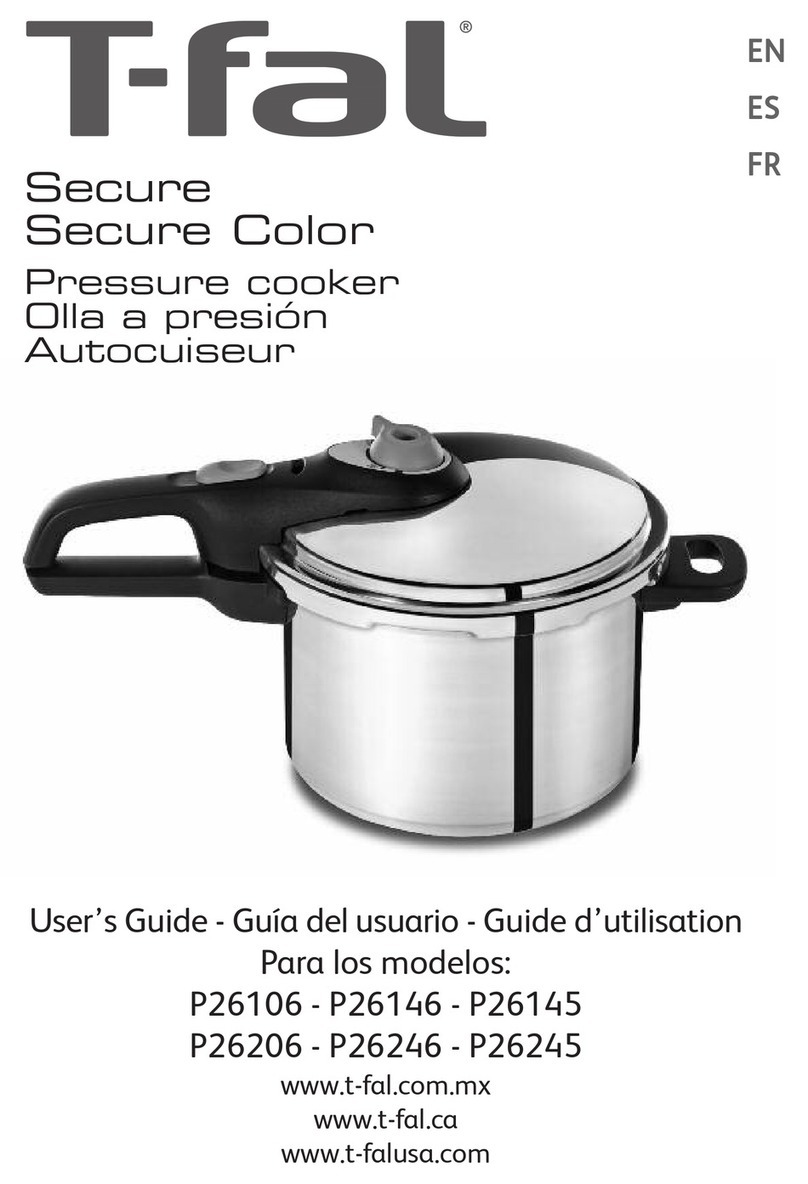
T-Fal
T-Fal P26106 User manual
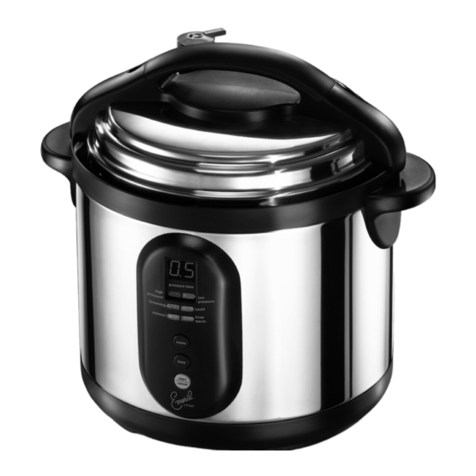
T-Fal
T-Fal EMERIL User manual
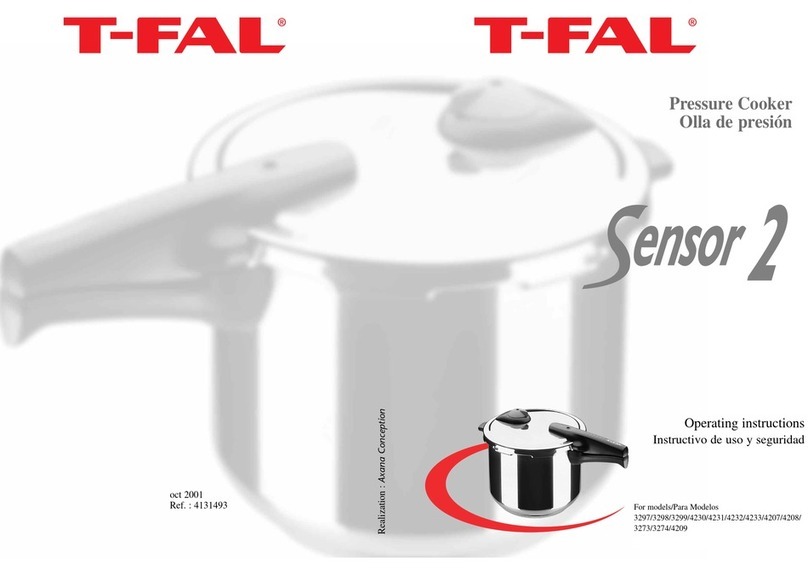
T-Fal
T-Fal SENSOR 2 User manual
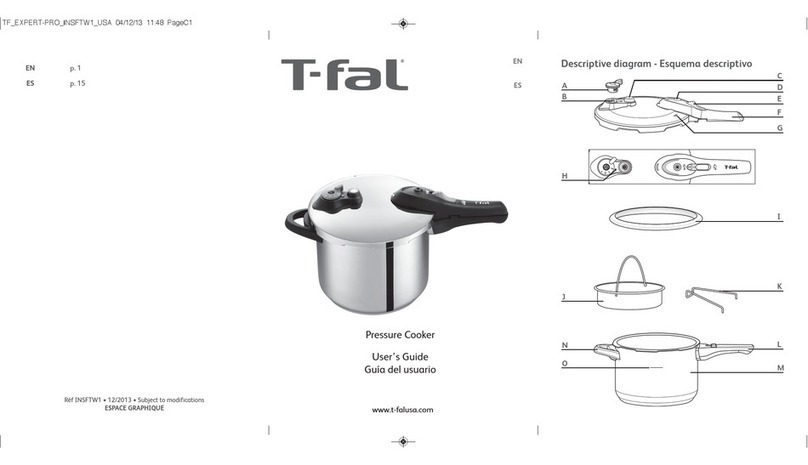
T-Fal
T-Fal Pressure Cooker User manual

T-Fal
T-Fal RAPID PRO User manual

T-Fal
T-Fal P4500936 User manual

T-Fal
T-Fal YS223H64 User manual

T-Fal
T-Fal P2510740 User manual
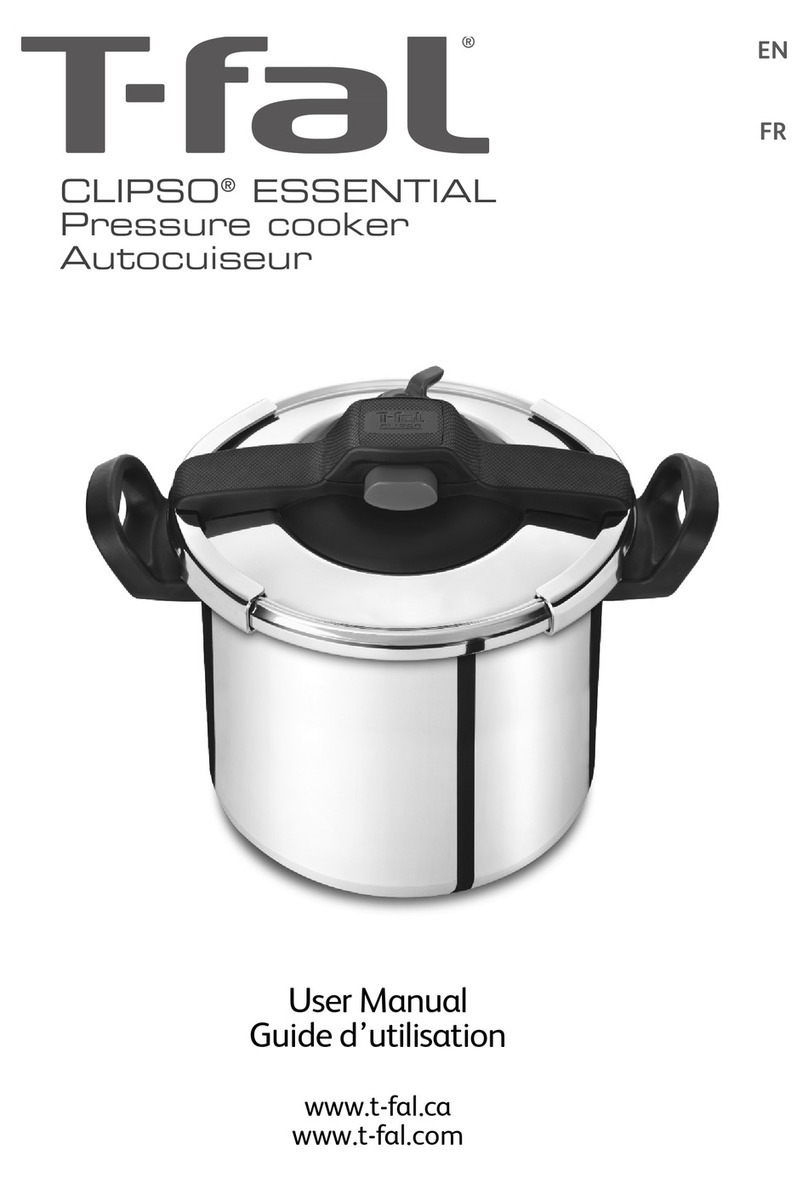
T-Fal
T-Fal Clipso Essential User manual

